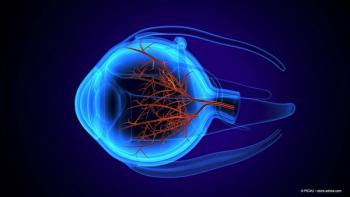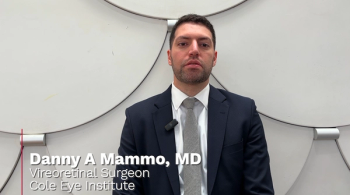
Ultra-widefield imaging provides visibility of the posterior segment in KPro patients
Scanning laser ophthalmoscopy offers improved view of posterior segment.
Reviewed by William R. Bloom and Colleen M. Cebulla, MD, PhD.
The posterior segment is not readily visible in patients implanted with a Boston type I and II keratoprosthesis (KPro, Massachusetts Eye and Ear) when using standard fundus examination and photography.
However, ultra-widefield imaging scanning laser ophthalmoscopy seems to have remedied this and facilitates noninvasive monitoring of pathologies in the retina and optic nerve, according to William Bloom and Colleen Cebulla, MD, PhD, both of the Department of Ophthalmology and Visual Sciences at The Ohio State University Wexner Medical Center in Columbus.
Related:
The investigators conducted a retrospective chart review of 15 eyes of 14 patients who received either the Boston type I (n=14 eyes) or II (n=1 eye) KPro between 2009 and 2020 at the Wexner Medical Center.
The Optos ultra-widefield imaging system was used during 35 patient visits. A single masked reader graded image quality as poor, fair, good, or very good. The images were assessed for clinical pathologies of the retina and optic nerve.
Related:
Poor image was defined as one in which the structure of the optic disc or posterior segment was incomplete without meaningful clarity; fair image was defined as providing moderate structural resolution but not showing the complete posterior pole; good image was defined as providing a clear view of the entire posterior pole; and very good image was defined as excellent resolution with a field of view to the equatorial retina, Bloom explained.
Image quality
The image quality assessed was as follows: 1 of 35 images (2.9%) was considered poor and provided no visualization of posterior segment structures; 34 of 35 images (97.1%) were assessed as fair, good, or very good and provided at least some clinical utility.
Images that were clinically useful were obtained in the presence of both KPro models. Both the optic nerve and the macula were visible in 33 of 35 images (94.3%). Clinical pathologies in the study eyes included glaucoma, macular degeneration, and repaired retinal detachment. In 4 eyes, ultra-widefield images was performed serially at multiple visits (range, 3-9 individual visits), allowing for longitudinal follow-up (range, 3-46 months), Bloom said.
The investigators pointed out that images that were clinically useful were obtained despite poor visual acuity.
Related:
“This ability allowed for longitudinal monitoring of insidious ocular clinical pathology, such as age-related macular degeneration and glaucoma,” the investigators wrote. “The ultra-widefield imaging provided clinically meaningful visualization of the optic nerve and anterior retina in most patients.”
The investigators also noted that in the presence of a retroprosthetic membrane the image quality was affected and it was difficult to image the anterior retina in all 4 quadrants simultaneously. However, implementing eye steering techniques, changing patient positions, and obtaining multiple images during an imaging session helped overcome these limitations.
Related:
Based on the results, ultra-widefield imaging was considered to be valuable because it can be performed rapidly and reliably to image the posterior segment compared with the standard technologies.
“Ultra-widefield imaging provides adequate visualization of the posterior segment in patients implanted with the KPro. Importantly, this imaging modality allowed noninvasive longitudinal monitoring of the retinal and optic nerve clinical pathology in this select patient population,” they concluded.
William R. Bloom
E: William.Bloom@osumc.edu
This article is adapted from Bloom’s presentation at the Association for Research in Vision and Ophthalmology 2021 annual meeting held virtually in May. He has no financial interest in this subject matter.
Colleen M. Cebulla, MD, PhD
E: colleen.cebulla@osumc.edu
Cebulla has no financial interest in this subject matter.
Related Content:
Newsletter
Keep your retina practice on the forefront—subscribe for expert analysis and emerging trends in retinal disease management.
















































